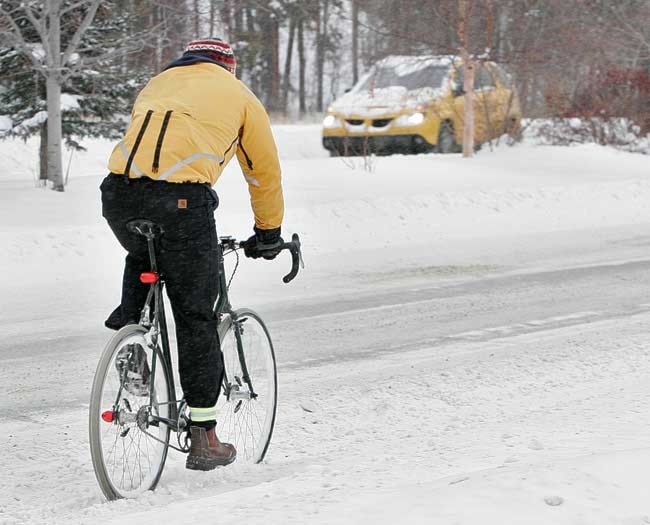Jonah Clark is used to losing control, and likes it.
He is a winter cyclist.
“I’ve developed a perverse enjoyment with snow riding,” says the former Winnipeg bike messenger, as he laughs and talks of tricks like skidding his back tire around corners.
Clark has been riding his bike in the winter for 12 years and commutes through a maze of trails, parking lots and less-busy roads to get downtown from his Hillcrest home each day.
Bicycles have a right to be on the roads - all year round, he says.
“Bicycles are technically as legitimate as motor transportation to get around, arguably better for the environment for sure, and better for your own physical health.”
Compared to Winnipeg, Whitehorse fares well in respecting the rights of bikers, he says.
Drivers and riders have to get along, especially in the winter.
Bike lanes are not a priority for snow and ice removal, says Whitehorse Mayor Bev Buckway, adding the snow and ice control policy will be reviewed again in the next few months.
“A lot of it comes down to budgets,” she says, adding the city tries to clean the bike lanes when it can.
However, that doesn’t mean council does not support the burgeoning community of winter cyclists.
At Monday’s meeting, council unanimously agreed to give the Riverdale Community Association a $500 environmental grant for a winter cycling workshop.
“It’s to provide encouragement and information for people who want to winter cycle,” says Jenny Trapnell, a founder of the Riverdale Community Association.
The workshop will be as much about enjoyment as it is about safety and will be free to the community at large, not just Riverdale residents, she says.
Having landed the money, Trapnell is now planning the workshop and hopes to put it on in late January.
This will allow time to collaborate with all interested parties - including retailers, which can talk about all the safety tools and equipment, and bylaw, which may want to run through some rules.
“The city’s invested a lot in infrastructure to support biking,” says Trapnell. “It would seem to make sense to try and extend the biking season for all those supports that are in place.”
In fact, politicians approved another environmental grant on Monday to pay for half of a new, custom-made, art-piece bike rack for Many Rivers Counselling.
The workshop may not generate many more winter riders but it could be a start, says Trapnell, mentioning Whitehorse’s robust, summer bike community and the small gatherings of winter cyclists she knows already exist.
More than anything else, winter biking is another way to encourage people to get out, exercise and enjoy the outdoors, says Trapnell.
She’s just started her career as a winter cyclist. So far she avoided commuting, but ventures out later in the night on empty streets, getting used to the feel of her studded bike tires in the snow and ice tracks made by cars.
She enjoys it, and feels safer on her bike than she does walking at night.
Clark takes winter biking recreation to a whole new level.
The tires on his snow bike are huge.
His fellow mountain bikers still get together in the winter and explore the snowmobile and dog-mushing trails.
“Dog-mushing trails are the best for snow biking,” he says, listing the Iditarod and Yukon Quest’s lesser-known cousins: the Iditabike and Yukon Arctic-Ultra - which will be back in Whitehorse this coming February.
But whether biking around your subdivision, to work or all the way from Whitehorse to Dawson City, Clark says there are a few things all winter bikers should know.
The more reflective the better. Cover every inch of skin - especially the hands and feet. Always have a light. Get to know the city and all the back roads and paths to avoid high-traffic areas. Splurge on studded tires. And practise, practise, practise, he says.
“Pedestrians and cyclists both tend to be invisible in the winter,” he says. “You want to be conscientious. Ride in the wheel rut when you can and, if you have an aggravated car behind you, give them the right of way because it’s not worth the confrontation or your safety and car drivers tend to not realize quite how dangerous the vehicle is that they’re driving most of the time.”
Contact Roxanne Stasyszyn at
roxannes@yukon-news.com
